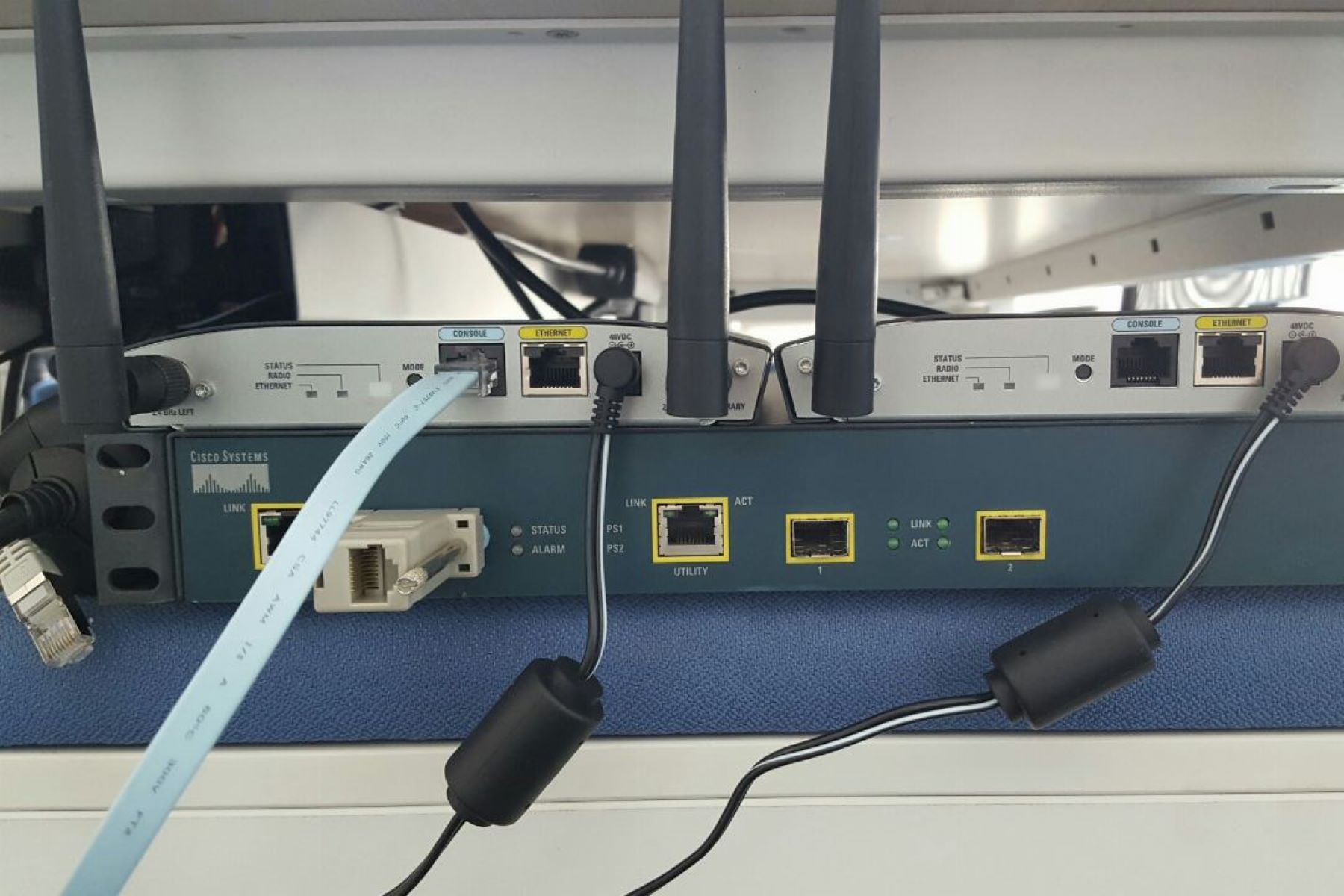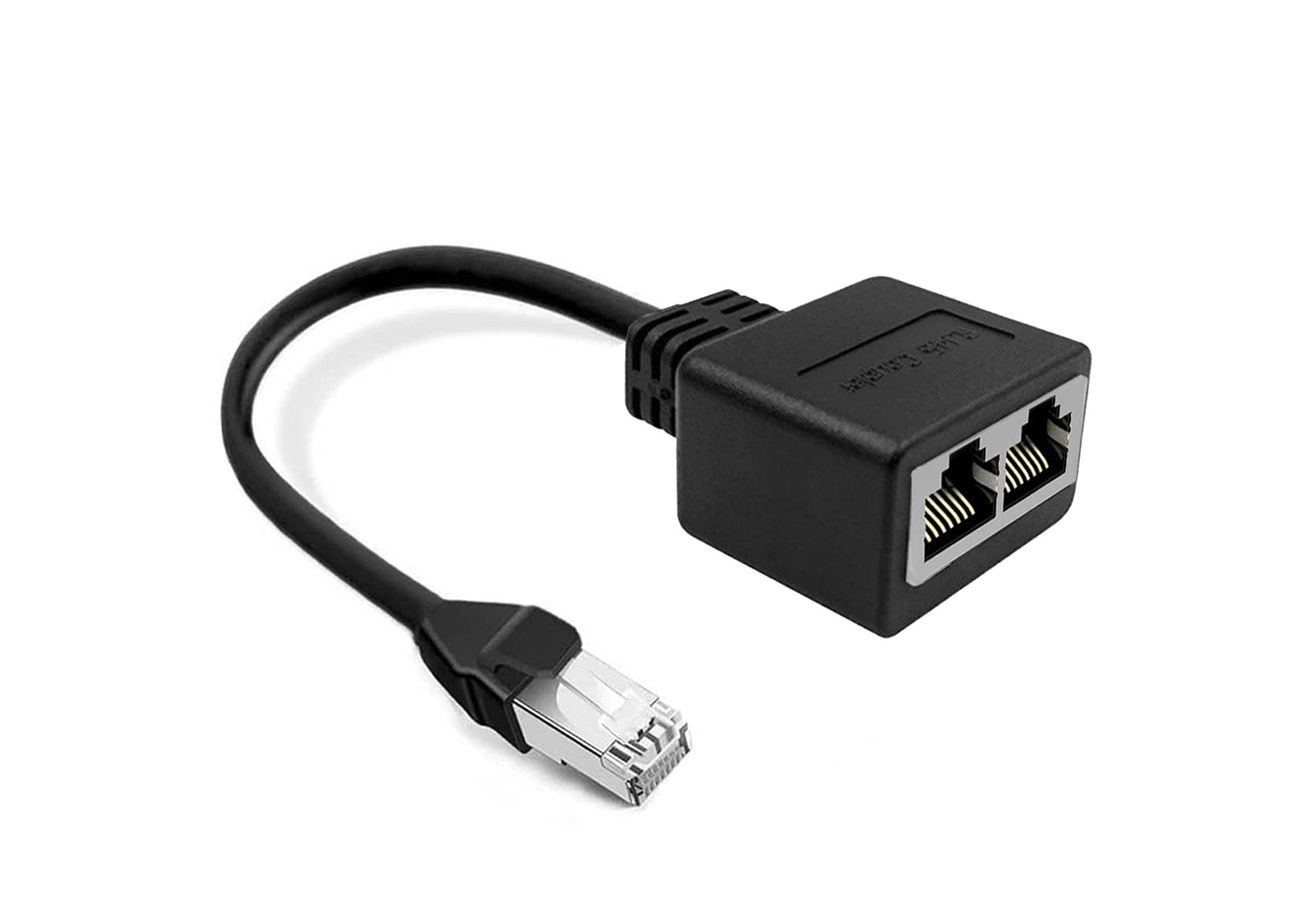Introduction
Ethernet is a widely used standard for local area networks (LANs) that enables the interconnection of computers and other devices within a specific geographical area. Originally developed by Xerox Corporation in the 1970s, it has become the most prevalent technology for wired network communications due to its simplicity, reliability, and scalability.
Ethernet allows devices to communicate with each other by sending and receiving data packets over a physical network. It defines the rules and specifications for the transmission of these packets, ensuring efficient and error-free data transfer.
In today’s interconnected world, Ethernet has evolved to support higher speeds and accommodate various network configurations. It has found applications in both residential and commercial settings, enabling seamless connectivity for households, offices, schools, and data centers.
This article will delve into the details of Ethernet, including its definition, history, standards, cabling and connectors, data transmission process, network topology, and the advantages and disadvantages it offers. By the end of this article, you will have a comprehensive understanding of Ethernet and its significance in modern networking.
Definition of Ethernet
Ethernet refers to a family of wired networking technologies that are used for local area networks (LANs). It provides a standardized set of rules and protocols for transmitting data packets between devices over a physical network, ensuring efficient and reliable communication.
In Ethernet, data is organized into packets, which are encapsulated with source and destination addresses, error detection codes, and other necessary information. These packets are then transmitted over a network medium, such as copper or fiber-optic cables, to the intended recipient.
One of the key features of Ethernet is its ability to handle multiple devices connected to the same network. Each device on the Ethernet network has a unique identifier, known as a Media Access Control (MAC) address. This allows for the identification and delivery of data packets to the appropriate device.
Ethernet operates using the Carrier Sense Multiple Access with Collision Detection (CSMA/CD) protocol, which ensures that multiple devices on the network can transmit and receive data without collisions. In CSMA/CD, each device listens to the network before transmitting data to avoid interference with other devices.
The Ethernet standard has evolved over time, with various iterations offering different speeds and capabilities. Initially, Ethernet operated at a maximum speed of 10 megabits per second (Mbps). However, advancements in technology have led to the development of Fast Ethernet (100 Mbps), Gigabit Ethernet (1 gigabit per second or Gbps), and even higher speeds such as 10 Gbps, 40 Gbps, and 100 Gbps.
Overall, Ethernet serves as the foundation for wired networking, connecting devices within a local area network and enabling the efficient and reliable transfer of data. Its widespread adoption and continuous evolution make it an integral part of modern computing and communication systems.
History of Ethernet
The history of Ethernet dates back to the 1970s when it was first developed at Xerox Corporation’s Palo Alto Research Center (PARC). A team led by Robert Metcalfe and David Boggs set out to create a networking technology that could connect different devices and computers together.
The original Ethernet design, called Ethernet Version 1.0, had a data transfer rate of 2.94 Mbps and used coaxial cables to connect devices. It allowed for multiple devices to share the same communication medium, enabling simultaneous data transmission and reception.
In 1980, Digital Equipment Corporation, Intel, and Xerox formed the DIX (Digital, Intel, Xerox) consortium to further develop and standardize Ethernet. This consortium released Ethernet Version 2.0, which introduced several improvements, including support for both thick and thin coaxial cables, and an increased data transfer rate of 10 Mbps.
As Ethernet gained popularity, it became apparent that a more comprehensive standard was needed to ensure compatibility and interoperability among different vendors’ equipment. In 1983, the Institute of Electrical and Electronics Engineers (IEEE) established the 802.3 standard, which defined Ethernet as a standardized networking technology.
Over the years, Ethernet underwent significant advancements. In the 1990s, Fast Ethernet was introduced, delivering data transfer rates of 100 Mbps. This upgrade allowed for faster and more efficient network communication, keeping up with the growing demands of networked environments.
With the turn of the century, Gigabit Ethernet emerged, providing speeds of up to 1 Gbps. Gigabit Ethernet was widely adopted in enterprise networks, data centers, and high-bandwidth applications.
In recent years, Ethernet has continued to evolve to meet the demand for even higher speeds. Technologies such as 10 Gigabit Ethernet, 40 Gigabit Ethernet, and 100 Gigabit Ethernet have been introduced to support the increasing bandwidth requirements of modern networks.
Today, Ethernet has become the de facto standard for wired networking, connecting devices in homes, offices, schools, and data centers worldwide. Its rich history and continuous development have made it an indispensable component of our interconnected world.
Ethernet Standards
Ethernet standards define the specific rules and specifications that govern the operation and implementation of Ethernet technology. These standards ensure compatibility and interoperability between different Ethernet devices and networks.
The Institute of Electrical and Electronics Engineers (IEEE) has been instrumental in developing and maintaining Ethernet standards. The most commonly used Ethernet standards are part of the IEEE 802.3 standard, which encompasses various iterations and enhancements to the original Ethernet technology.
Some of the notable Ethernet standards include:
- 10BASE-T: This standard defines Ethernet over twisted-pair copper cables, with a maximum data transfer rate of 10 megabits per second (Mbps). It is widely used in residential and small office networks.
- 100BASE-TX: Also known as Fast Ethernet, this standard supports data transfer rates of 100 Mbps over twisted-pair copper cables. It offers a tenfold increase in speed compared to 10BASE-T.
- 1000BASE-T: This standard, commonly known as Gigabit Ethernet, allows for data transfer rates of 1 gigabit per second (Gbps) over twisted-pair copper cables. It provides significantly faster transmission speeds, catering to high-bandwidth applications.
- 10GBASE-T: This standard enables data transfer rates of 10 Gbps over twisted-pair copper cables. It provides faster speeds for enterprise networks, data centers, and other high-performance environments.
- 10GBASE-SR: This standard supports data transfer rates of 10 Gbps over multi-mode fiber-optic cables, with shorter transmission distances. It is commonly used in data centers and intra-building connections.
- 40GBASE-SR4: This standard allows for data transfer rates of 40 Gbps over multi-mode fiber-optic cables, with longer transmission distances compared to 10GBASE-SR. It is used in high-bandwidth applications and data center environments.
- 100GBASE-SR4: This standard enables data transfer rates of 100 Gbps over multi-mode fiber-optic cables. It provides the highest transmission speeds currently available for Ethernet networks.
These standards, among others, ensure that different Ethernet devices can communicate seamlessly on the same network, regardless of their hardware manufacturers. They offer flexibility and scalability, allowing networks to be upgraded and adapted to meet evolving business and technological requirements.
It is important for network administrators and IT professionals to understand the various Ethernet standards to ensure proper implementation and interoperability within their networks.
Ethernet Cabling and Connectors
Ethernet networks rely on specific types of cables and connectors to transmit data between devices. The choice of cabling and connectors depends on the desired speed, distance, and environmental factors. Here are some commonly used Ethernet cabling and connector types:
- Twisted-Pair Copper Cables: Twisted-pair cables are one of the most widely used types of Ethernet cables. These cables consist of pairs of insulated copper wires twisted together to reduce crosstalk and electromagnetic interference. The two main categories of twisted-pair cables used in Ethernet networks are Unshielded Twisted Pair (UTP) and Shielded Twisted Pair (STP). UTP cables, particularly Cat5e and Cat6, are commonly used for Ethernet connections within homes and small businesses, while STP cables are typically used in environments with high electrical noise.
- Fiber-Optic Cables: Fiber-optic cables use strands of glass or plastic fibers to transmit data as pulses of light. They provide faster speeds, greater bandwidth, and longer transmission distances compared to copper cables. Fiber-optic cables are classified into single-mode and multi-mode fibers. Single-mode fibers are used for long-distance applications, such as interconnecting buildings, while multi-mode fibers are suitable for shorter distances within a single building or data center.
- RJ-45 Connector: The RJ-45 connector is the standard connector used for Ethernet twisted-pair copper cables. It has eight pins that connect to the eight wires within the cable, allowing for transmission and reception of data signals. The RJ-45 connector is firmly attached to the end of the Ethernet cable and plugs into the Ethernet port on devices such as computers, routers, and switches.
- LC Connector: The LC connector is a small, push-pull fiber-optic connector used for connections on multi-mode and single-mode fiber-optic cables. It provides a secure and reliable connection with low insertion loss. The LC connector is commonly used in data centers, telecommunications, and high-speed Ethernet applications.
- SC Connector: The SC connector is another popular fiber-optic connector used with both single-mode and multi-mode fiber-optic cables. It features a square-shaped push-pull design that provides quick and easy connections. The SC connector is commonly used in enterprise networks and telecommunication systems.
The selection of the appropriate cabling and connectors is crucial for ensuring optimal Ethernet performance. Factors such as the desired data speed, distance, electromagnetic interference, and budgetary considerations need to be taken into account. Proper installation and adherence to industry standards are also critical for maintaining reliable and efficient network connectivity.
Ethernet Data Transmission
Ethernet data transmission involves the exchange of data packets between devices connected to an Ethernet network. When a device wants to send data to another device, it follows a specific process to ensure successful communication.
The data transmission process in Ethernet can be summarized as follows:
- Packetization: The data to be transmitted is divided into smaller units called packets. Each packet contains the data, source and destination addresses, error detection codes, and other necessary information.
- Addressing: Each Ethernet device on the network has a unique identifier, known as a Media Access Control (MAC) address. The source MAC address is included in the packet to identify the sending device, and the destination MAC address is included to specify the intended recipient.
- Carrier Sense Multiple Access with Collision Detection (CSMA/CD): Before transmitting data, a device listens to the network to check if any other device is currently transmitting. If the network is idle, the device proceeds to send the packet. If the network is busy, the device waits for an appropriate time to transmit its data.
- Data Transmission: The device sends the packet onto the Ethernet network. The packet is transmitted as electrical or optical signals depending on the type of cabling used (e.g., copper or fiber optic).
- Collision Detection: If two devices attempt to transmit data at the same time and a collision occurs, each device detects the collision and waits for a random period before reattempting the transmission. This process avoids data corruption due to simultaneous transmission attempts.
- Receipt and Acknowledgment: The destination device receives the packet and checks its integrity. If the packet is error-free, the receiving device sends an acknowledgment to the sender, confirming successful packet delivery. In case of errors, the packet may be retransmitted.
Ethernet data transmission follows these steps for each packet sent across the network. These processes help ensure reliable and efficient communication, minimizing errors and maximizing the utilization of available network resources.
As Ethernet technology has evolved, higher data transfer speeds, improved error detection, and correction mechanisms have been introduced to enhance data transmission efficiency. These advancements have made Ethernet an integral part of modern networking, supporting the seamless transfer of data across various devices and applications.
Ethernet Network Topology
Ethernet networks can be structured in different topologies that dictate how devices are interconnected. The network topology determines the overall structure and communication patterns within the network.
Here are some common Ethernet network topologies:
- Bus Topology: In a bus topology, all devices are connected to a single communication medium, typically a coaxial cable. Each device taps into the cable, and data is transmitted along the shared channel. However, bus topologies have limitations, such as vulnerability to single-point failures and difficulty in troubleshooting.
- Star Topology: In a star topology, each device is directly connected to a central device, usually a switch or hub, using individual twisted-pair cables. All communication is routed through the central device, which acts as a central hub for data transmission. Star topologies provide better scalability, easier troubleshooting, and the ability to isolate network issues to specific devices.
- Ring Topology: In a ring topology, each device is connected to the adjacent devices, forming a closed loop. Data travels in one direction around the ring until it reaches its destination. Ring topologies provide resilience against single-point failures as data can be rerouted in the opposite direction in case any segment of the ring fails.
- Mesh Topology: A mesh topology involves connecting each device to every other device in the network. This creates redundant paths for data transmission, ensuring high availability and fault tolerance. However, mesh topologies can be complex and require a considerable number of connections, making them more suitable for large-scale enterprise networks.
- Hybrid Topology: Hybrid topologies combine two or more basic topologies to create a customized network structure that suits specific requirements. For example, a combination of star and ring topologies can be used to balance scalability and fault tolerance in a network.
The choice of network topology depends on factors such as the scale of the network, the desired level of fault tolerance, ease of management, and the budgetary constraints. Each topology has its own advantages and considerations, and organizations must choose the appropriate topology to meet their specific networking needs.
Ethernet networks can also be extended through VLANs (Virtual Local Area Networks) and switches, allowing for the segmentation and isolation of network traffic for enhanced security and performance.
Understanding Ethernet network topologies is crucial for network administrators and IT professionals, as it impacts network design, performance, and troubleshooting strategies.
Advantages and Disadvantages of Ethernet
Ethernet technology offers several advantages that have contributed to its widespread adoption and dominance in wired networking. However, it also has its limitations and drawbacks. Let’s explore the advantages and disadvantages of Ethernet:
Advantages of Ethernet:
- Wide Availability: Ethernet is a widely available technology, with support for both residential and enterprise networks. It is an industry standard and has become the de facto choice for wired network connectivity.
- Reliability: Ethernet provides reliable and stable network connectivity. It has built-in error detection and correction mechanisms, ensuring the integrity and accuracy of data transmission.
- Scalability: Ethernet networks can easily be scaled to accommodate additional devices and increased network traffic. It offers flexibility in terms of network expansion and supports different network topologies to suit varying requirements.
- High-Speed Data Transfer: Ethernet has evolved to support high-speed data transfer rates. With advancements such as Gigabit Ethernet and 10 Gigabit Ethernet, it provides the necessary bandwidth to handle large amounts of data efficiently.
- Cost-Effective: Ethernet technology is cost-effective, both in terms of installation and maintenance. The availability of standardized components, simplicity of deployment, and competition among vendors contribute to its affordability.
Disadvantages of Ethernet:
- Distance Limitations: Ethernet has distance limitations, especially for certain types of cabling. In copper-based Ethernet, the maximum reliable distance is limited, beyond which signal degradation occurs. Fiber-optic Ethernet can overcome this limitation but comes at a higher cost.
- Physical Limitations: Ethernet uses physical cables to transmit data, which can limit mobility and flexibility compared to wireless networking technologies. However, advancements such as Power over Ethernet (PoE) have allowed for the transmission of power and data over the same cable, offering more flexibility.
- Complexity in Large Networks: Managing and troubleshooting large Ethernet networks with numerous devices and network segments can be complex. Configuring and maintaining network switches, ensuring proper VLAN setup, and resolving network issues may require specialized knowledge and expertise.
- Shared Network Resources: In Ethernet networks, devices share the available network bandwidth. This can result in congestion and decreased performance, especially in heavily utilized networks or during peak usage periods.
- Security Concerns: Ethernet networks are susceptible to security threats, including unauthorized access, eavesdropping, and data interception. Implementing security measures such as encryption, access control, and network segmentation becomes essential to mitigate these risks.
Understanding the advantages and disadvantages of Ethernet allows network administrators to make informed decisions when designing, implementing, and managing their network infrastructure. It is crucial to consider these factors to strike a balance between performance, scalability, cost, and security.
Conclusion
Ethernet has revolutionized the world of wired networking, providing a standardized and reliable solution for connecting devices within a local area network. Its development and evolution over the years have made it the most widely used networking technology.
From its humble beginnings in the 1970s to the present day, Ethernet has undergone several advancements, resulting in faster data transfer rates, improved reliability, and increased scalability. It offers a range of benefits, including wide availability, high-speed data transmission, flexibility, and cost-effectiveness.
Ethernet’s ability to support various network topologies and its compatibility with different devices make it a versatile choice for both residential and enterprise networks. Its standardized protocols ensure interoperability, allowing devices from different manufacturers to communicate seamlessly.
However, Ethernet does have limitations, such as distance restrictions for certain types of cabling, complexity in large networks, and the need for physical connections. Security concerns also need to be addressed to protect network data from unauthorized access.
In conclusion, Ethernet remains at the forefront of wired networking technology, enabling reliable and efficient communication across a wide range of devices and applications. Its continuous evolution and widespread adoption make it an integral part of modern networking infrastructure. As technology advances, Ethernet will continue to adapt and provide the foundation for future innovations in the field of network communications.

























